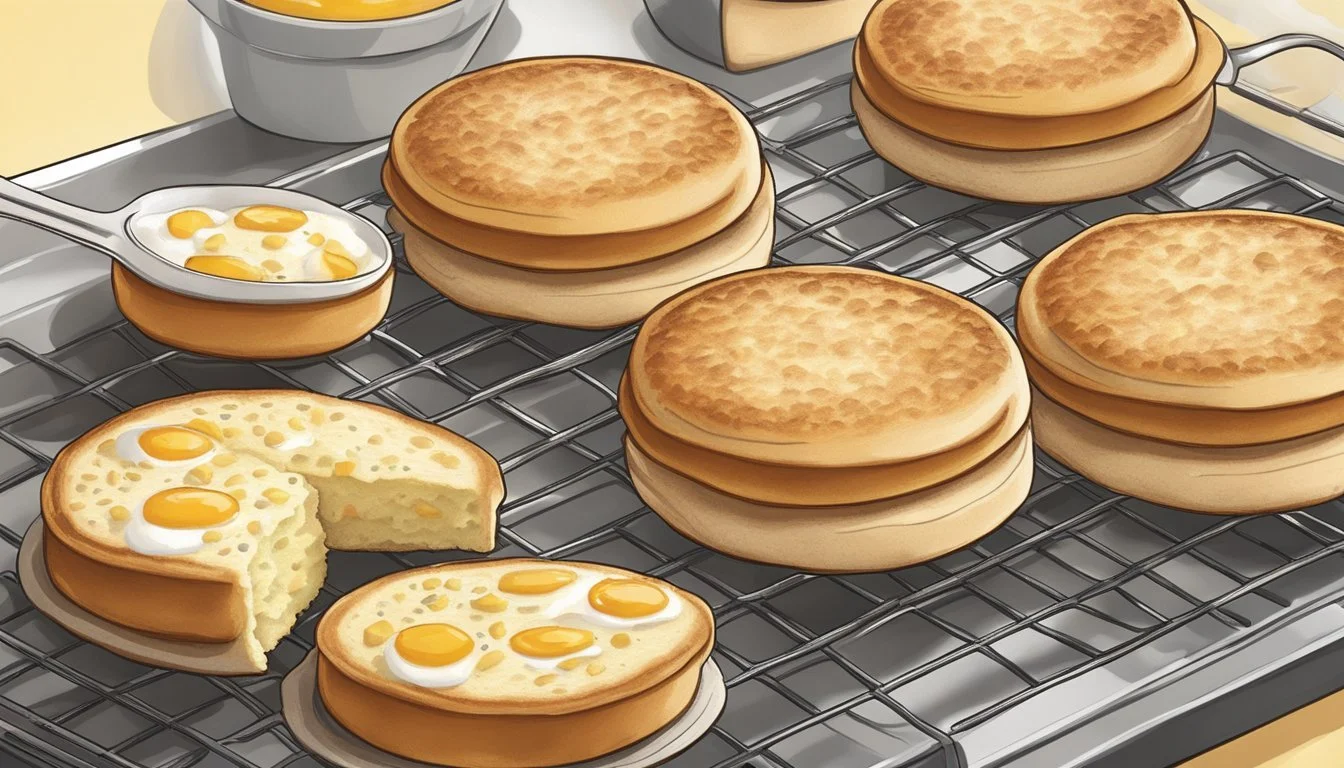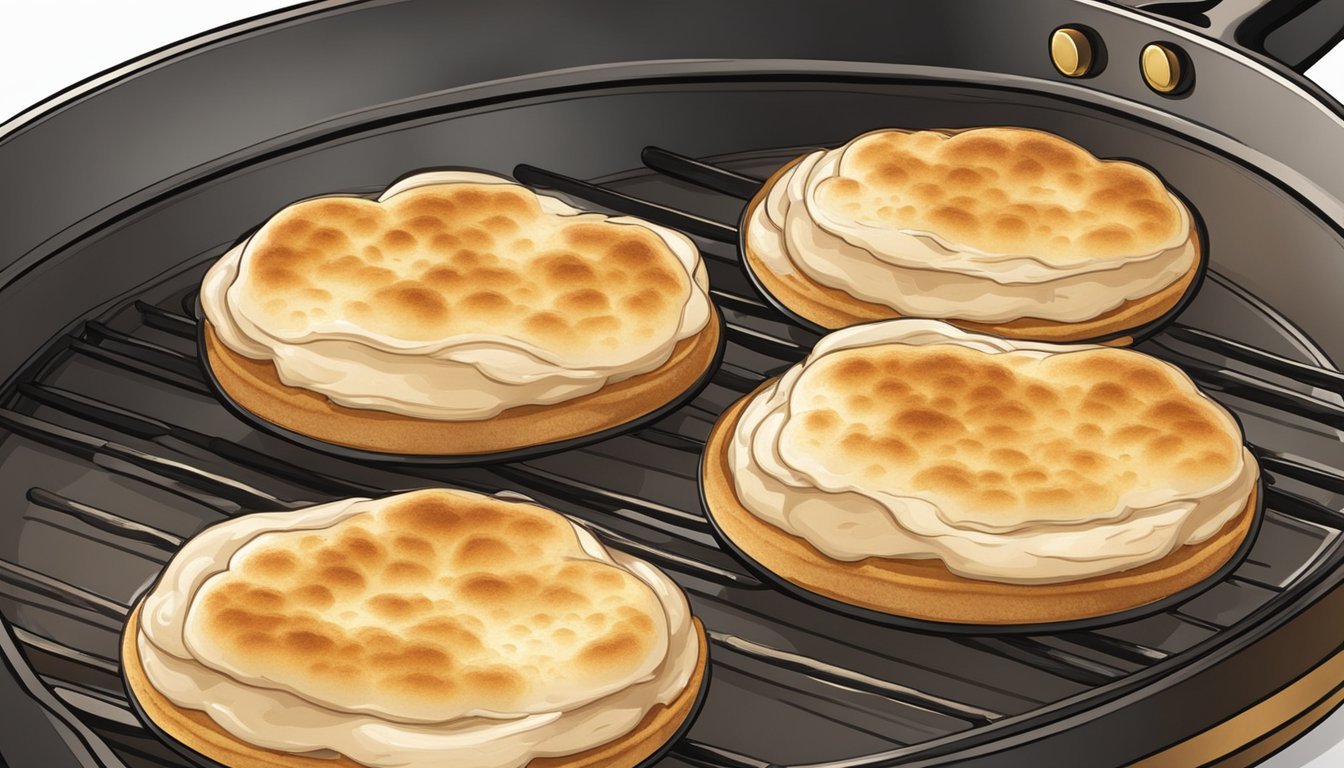Reviving Stale English Muffins
Tips for a Delicious Reheat
Stale English muffins might seem past their prime, but they can be revitalized with simple techniques. It's a common scenario: the muffins one has stashed away in the pantry or on the counter have become tough and dry. Rather than discarding them, these previously soft and crispy breakfast treats can be returned to a satisfying state with a couple of quick and straightforward methods.
Reviving English muffins is not only a move to reduce food waste but also a way to enjoy what could still be a delicious component of a meal. The texture of English muffins makes them particularly well-suited for refreshing, as their nooks and crannies can become crisp when toasted, while the insides remain soft.
Microwaving with a damp paper towel or reheating wrapped in aluminum foil in the oven are practical solutions that address the issue effectively. These methods gently reintroduce moisture and heat without further hardening the bread. With proper rejuvenation, stale English muffins can once again become a delightful part of a breakfast spread.
The Basics of English Muffins
English muffins are a distinct type of bread, notably different from their sweet, cake-like American counterparts. They are valued for their unique texture and taste, and have become a staple in breakfast menus.
History and Origins
English muffins originate from the United Kingdom, where they were historically part of the Victorian-era diet. They were cooked on a griddle, which contributed to their signature toasted crust and soft inner texture. Throughout history, the English muffin has traveled across the globe, adapting to various regional palates while maintaining its basic characteristics.
Essential Ingredients
A traditional English muffin recipe requires simple ingredients such as:
Yeast: To help the dough rise and create air pockets.
Milk: Often whole milk for a richer flavor.
All-purpose flour or a combination of bread flour and whole wheat flour: This mix delivers a well-balanced texture.
Cornmeal: Used to dust the muffins and prevent them from sticking during the cooking process.
Some variations might include semolina flour for a slightly different texture. The key to the English muffin's character lies in the balance of these ingredients.
Role in Breakfast Cuisine
English muffins have carved out a special place in breakfast cuisine due to their versatility. The nooks and crannies characteristic of these muffins make them ideal for holding melted butter, jam, or any breakfast spread. They're also the foundational bread in the classic Eggs Benedict recipe, illustrating their enduring popularity in breakfast and brunch dishes (What wine goes well with brunch dishes?).
Preparing English Muffins
When making homemade English muffins, the process involves creating a workable dough, shaping the muffins accurately, allowing the dough to rise, and finally cooking them to achieve the classic nooks and crannies. Precision in each step ensures the right texture and taste.
Creating the Dough
A chef must start by mixing high-protein flour with yeast, sugar, salt, and water. The ingredients are combined until a sticky dough forms. They meticulously knead the dough for about 10 minutes, either by hand or with a mixer, until it's smooth and elastic, ensuring a chewy texture upon cooking.
Shaping and Cutting
Once the dough is kneaded, it is rolled out to an even thickness, typically about 1/2 inch. A round cutter is then used to shape the muffins. Any excess dough can be re-kneaded and rolled out to minimize waste.
The Rising Process
The shaped muffins are transferred to a cornmeal-dusted surface to rise. This is done in a warm, draft-free area until they are puffy and almost doubled in size, often taking about 1 to 2 hours. This key process contributes to creating the signature nooks and crannies in the muffins.
Cooking on the Griddle
To finally cook the English muffins, a griddle is preheated to a moderate temperature. The muffins are then placed on the griddle, ensuring they're not overcrowded, and cooked for about 5 to 7 minutes on each side. They should have a golden-brown exterior, while the interior should be soft but cooked through, complete with the desired texture.
Enhancing Flavor and Texture
One can significantly improve stale English muffins by focusing on two key areas: the addition of flavorsome toppings and fillings, and the incorporation of distinct toasting methods to achieve the desired texture.
Toppings and Fillings
A wide variety of toppings and fillings can be used to enhance both the flavor and texture of English muffins. For a soft and fluffy experience, one might spread a generous layer of butter which melts into the warm nooks and crannies. Alternatively, for sweet lovers, jam or honey can amplify the taste with their natural sweetness. Those with a preference for savory can opt for peanut butter or creamy cheese spreads which add a rich dimension to the breakfast treat.
Sweet Options:
Jam
Honey
Savory Options:
Peanut Butter
Cream Cheese
Toasting Methods
The method of toasting English muffins can make a significant difference in their texture. To achieve a golden brown surface with a crisp exterior, one can toast the muffin until it develops a slightly crunchy crust. For those who prefer a soft, warm interior, they should toast the muffin for a shorter duration, ensuring it is heated through but not hardened.
For a Crisp Texture:
Toast until golden brown
For a Soft Inside:
Toast lightly until just warm
Using these techniques, stale English muffins can be transformed into a delightful breakfast with optimal taste and texture.
Storing and Reviving
When it comes to English muffins, maintaining their freshness is crucial while knowing how to rejuvenate them can save breakfast.
Proper Storage Techniques
To store English muffins effectively, one should seek a cool, dry place away from heat and light. The ideal temperature is typically between 68°F to 72°F. An airtight container or a resealable plastic bag can be instrumental in preserving their freshness by minimizing exposure to air and moisture, which can promote staleness. In terms of extending shelf life, the freezer provides an excellent option. Here’s a brief guide:
Room Temperature Storage: Place in a cool, dry spot; consume within 2-4 days.
Refrigeration:
Seal in an airtight container or a plastic bag with as much air removed as possible.
Can extend freshness for several days.
Freezing:
Wrap individually and place in freezer bags; remove air before sealing.
Freeze for up to 3 months to preserve quality.
Reviving Stale Muffins
Once an English muffin has gone stale, it’s not the end. There are techniques to bring back their softness and crispness. For a quick remedy, one can use the microwave. Place the stale muffin under a damp paper towel and heat in 10-second intervals until the desired softness is achieved. Alternatively, an oven can serve in reviving them:
Microwave Method:
Damp paper towel wrap.
Heat in intervals, checking for softness.
Oven Method:
Preheat oven to 350°F.
Place muffins in a paper bag with enough room for expansion to utilize steam.
Warm for 5-10 minutes or until satisfactorily revived.
By employing these storage and revival methods, one ensures English muffins remain a delightful and inviting component of any meal, whether enjoyed immediately after purchase or preserved for future enjoyment.
Creative Uses for English Muffins
English muffins serve as a versatile canvas for a range of culinary creations, from the familiar breakfast sandwich to innovative desserts and snacks. Their unique texture and mild flavor make them ideal for both savory and sweet applications.
Breakfast Sandwiches and Beyond
One can easily elevate their breakfast routine by using English muffins to craft delicious breakfast sandwiches. The nooks and crannies of the muffins are perfect for holding creamy cheese or a perfectly cooked egg. Pair with bacon or sausage for a classic combination, or explore more gourmet options like Eggs Benedict.
Classic Bacon, Egg, and Cheese: The quintessential breakfast sandwich includes crispy bacon, a soft, fried or scrambled egg, and a slice of melty cheese.
Sausage and Egg Delight: Swap out bacon for sausage patty rounds to provide a different texture and flavor.
Eggs Benedict Muffin: Top the muffin with ham, a poached egg, and drizzle with hollandaise sauce for a twist on the traditional Eggs Benedict.
Desserts and Snacks
Beyond breakfast, English muffins can be repurposed into various desserts and snacks. They are an excellent base for mini pizzas — a fun lunch, brunch (What wine goes well with brunch?), or snack option. Simply top with sauce, cheese, and toppings before broiling until bubbly and golden.
Mini Pizzas: Use the muffin halves as a base. Add tomato sauce, your favorite cheese, and various toppings like pepperoni or vegetables. Then, broil until the cheese is melted.
Sweet Treats: Transform them into a dessert by spreading with ricotta or cream cheese, a drizzle of honey, and a sprinkle of cinnamon.
Utilizing English muffins in these creative ways can spark joy in meal preparation and offer delightful tastes and textures in everyday eating.
Health and Nutrition
English muffins offer a nutritious choice for breakfast, providing essential nutrients while being low in calories and cholesterol. They are a versatile option that can fit into a balanced diet.
Calories and Macronutrients
An average English muffin contains about 134 calories. This calorie count is for plain English muffins and may be higher for those with added ingredients like dried fruit or cheese. In terms of macronutrients, these muffins offer a balance of carbohydrates, proteins, and a small amount of fat. Specifically, a standard English muffin made with white flour contains:
Carbohydrates: Approx. 25 grams
Protein: Approx. 5 grams
Fat: Less than 1 gram
Cholesterol: 0 milligrams
Whole wheat English muffins may have a slightly higher protein and fiber content due to the whole grains used.
Dietary Fiber and Whole Grains
Fiber is an important part of a healthy diet. It aids in digestion, helps control blood sugar levels, and can contribute to heart health. English muffins can be a source of dietary fiber, especially when made with whole wheat flour. A whole wheat English muffin typically contains:
Dietary fiber: 4-5 grams per serving
Choosing whole wheat options provides the benefits of whole grains, which have been linked to a lower risk of heart disease. The inclusion of whole wheat flour in English muffins not only increases their fiber content but also contributes to the overall nutrient density of the food.
Special Tips and Techniques
When reviving stale English muffins, one must focus on achieving a perfect rise during reheating and attaining a crispy exterior for an ideal texture.
Achieving the Perfect Rise
Temperature and cook time are crucial components for a perfect rise. To refresh stale English muffins, the oven should be preheated to 350°F (180°C). The muffins should then be lightly sprinkled with water and wrapped in foil to trap the moisture. They should be placed in the oven, which provides an even heat distribution, allowing for a gentle rise. The ideal heat time is around 5 minutes, ensuring they become soft without turning gummy.
Getting a Crispy Exterior
After the muffins have been heated through and have risen slightly, they should be finished off to get that desired crunch. Utilize the broiler for this final step. First, the English muffins should be removed from the foil and placed on a baking sheet. One should then broil the muffins for 1-2 minutes or until the desired crispiness is reached. It's important to watch them closely during this process, as the high heat from the broiler can cause muffins to burn quickly if left unattended. For those using a microwave, a quick 30-second burst at full power can steam the muffins, after which they can be crisped in a toaster.








